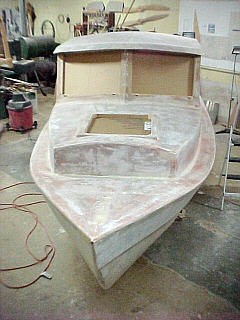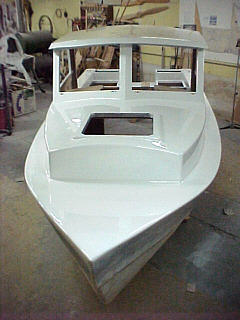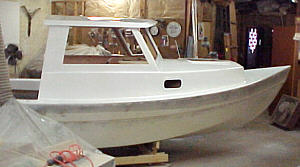|
Page 19
I had covered all the exterior surfaces with 6 oz. fiberglass cloth and epoxy resin. Like the hull it then requires that the surface be sanded until smooth. I tried several different sanders but the only one that seemed to remove the resin at a reasonable pace were my belt sanders with 40 or 60 grit belts. They did a good job of leveling the surface and the belts would not tend to clog like the paper in the orbital sanders. The downside of this is it left a fairly smooth surface but the course grit left somewhat deep scratches that need to be removed. I went to 100 grit in the orbital but still trying to work out all the scratch was a bear. During a week and a half period is spent over 26 hours sanding the exterior. I was sick of sanding and I thought it looked fairly decent so I decided to apply the sandable primer. As I think I mentioned before I am using Pettit's EasyPoxy. It call for using heir "White Undercoater" (#6149) as a sandable primer. I had some experience with this before when paint the hull - a Pettit paint tech had given be bad info and instructed me to use it under their "Polypoxy". I had already applied it when I realized it was the wrong primer. I had to sand it all back off! (Pettit did supply the correct primer at no cost.) At that time I was not impressed with its filling ability or its sandability. But it was rather cool in the shop (65 to 70 degrees) and I thought maybe that was the problem.
With this in mind I decided to spray the White Undercoater. As soon as I started spraying I could see in the wet primer that I hadn't yet sanded enough. Many of the scratches from the 60 grit belts were still visible. More *$$#**!!! sanding was still needed. I sprayed the rest of the surfaces and when home to brood about making more dust. As per the Undercoater label it should have been ready to sand in 4 hours. Four hours later - no go. Eight hours later still couldn't sand. Next day - no way. Finally, after 48 hours I could sand it with out clogging the paper. Unfortunately I also realized that it had done a poor job of filling the defects and I estimated that least 2 or maybe even 3 more coats would be necessary to fill it properly. If I used the Undercoater I would have to order another gallon spending $70 more and at least another week waiting and sanding.
DISCLAIMER - this may be a total screw up so use my method at your own risk. In the past I have sprayed numerous items with automotive lacquer based primer. It dries in 20 minutes, fills well and sands very easily. I also like the gray color because when you sand it the surfaces becomes a lighter color and you can see where you still need more fill (stays dark). With the White Undercoater it was almost impossible to tell what was going on. The question was would it work under the Easypoxy or would the paint lift it?
I then rolled on a coat of Easypoxy and tipped it off with a brush. The first piece looked pretty good but the others all seemed to develop a lot of what appeared to be dust in the finish. It really didn't look like it was raising the primer but obviously something was wrong. I decide to crawl up on the skiff and put some paint on the top. This was directly over the White Undercoater - still had what looked like dust. What is going on! I strained some of the paint and even there was more solids in it than I expected but I still got the dust. I had a quart of blue Easypoxy for striping and I tried it to see if it was the paint - no improvement. Maybe it is the roller or the brush. I was using a foam roller so I decided just to brush it on - still there! The brush was a brand new 3" $8 man made bristle brush designed for either latex or oil based paint. I grabbed one on my $1 chip brushes I used for spreading epoxy which has natural bristles and painted on some Easypoxy - slick as a whistle!!!! The brush was the problem. Although not visible the fine tips must have been dissolving and causing the "dust". Was the paint causing this or the lacquer thinner that I was using to clean the brush? I really am not sure but as long as the problem is gone I really don't care.
Now, back to the primer. A second test with the new brush worked great. No dust OR raising took place - I'm going for it! I knew I wouldn't have enough of the primer so a trip to the auto parts store set me back $30 for a new gallon. I sprayed on two coats and sanded it with 220 grit paper in a 1/4 sheet electric orbital sander. I was done in about 3 hours! I did sand completely through the primer in most spots but since I was hitting epoxy or the White Undercoater (as opposed to bear metal on a car) I really didn't worry about it. It kinda looked like "urban camouflage" when I was done! But I was done, done sanding for now!!!! And the surface was smooooth! I really don't think I would use the lacquer primer below the water line but I can see no reason it won't work above. I maybe complete wrong about this and only time will tell for sure.
|
 I
have to admit that the finishing process is my least favorite when building
any project. Actually, it is not the finishing itself I hate but
the SANDING it takes to get to the point of applying the finish. And on
the Cabin Skiff there is a lot of sanding!
I
have to admit that the finishing process is my least favorite when building
any project. Actually, it is not the finishing itself I hate but
the SANDING it takes to get to the point of applying the finish. And on
the Cabin Skiff there is a lot of sanding!
 Also,
when I applied it on the hull I rolled it on. This process left dimples
I thought would flow out - they didn't. Sanding just to level the
dimples would have removed almost all the primer. I probably would have
been better off if I had used a brush to "tip off" the dimples (run a brush
lightly over the wet primer).
Also,
when I applied it on the hull I rolled it on. This process left dimples
I thought would flow out - they didn't. Sanding just to level the
dimples would have removed almost all the primer. I probably would have
been better off if I had used a brush to "tip off" the dimples (run a brush
lightly over the wet primer).
 The
next day, Monday July 3, I decided to call Pettit paint tech
support and ask if there was another way around this - they were closed
for a long week end for the 4th of July. At this point I had had
enough. Trying to get accurate information about paint for the CS
has been the most aggravating part of the project. Frankly I was sick of
getting conflicting answers from different paint techs working for the
SAME company. I had already had to sand off one of their last recommendations
so I decided to forget them and trust my own judgment.
The
next day, Monday July 3, I decided to call Pettit paint tech
support and ask if there was another way around this - they were closed
for a long week end for the 4th of July. At this point I had had
enough. Trying to get accurate information about paint for the CS
has been the most aggravating part of the project. Frankly I was sick of
getting conflicting answers from different paint techs working for the
SAME company. I had already had to sand off one of their last recommendations
so I decided to forget them and trust my own judgment.
 I
had about a half gallon sitting in the shop so decided to spray some on
some bare plywood, some hardwood and some plywood scraps that were epoxy
coated. After allowing to dry for 20 minutes I sanded them.
The bare plywood and hardwood both needed another coat as the grain was
still visible. The epoxy covered wood looked good so I left it alone.
I
had about a half gallon sitting in the shop so decided to spray some on
some bare plywood, some hardwood and some plywood scraps that were epoxy
coated. After allowing to dry for 20 minutes I sanded them.
The bare plywood and hardwood both needed another coat as the grain was
still visible. The epoxy covered wood looked good so I left it alone.
 The
chip brushes are fairly course and stiff and a softer bristle seems to
work better. I went to the hardware store and bought a $7 three inch
natural bristle brush and it worked just fine. Like I said, the paint
has been a nightmare!
The
chip brushes are fairly course and stiff and a softer bristle seems to
work better. I went to the hardware store and bought a $7 three inch
natural bristle brush and it worked just fine. Like I said, the paint
has been a nightmare!